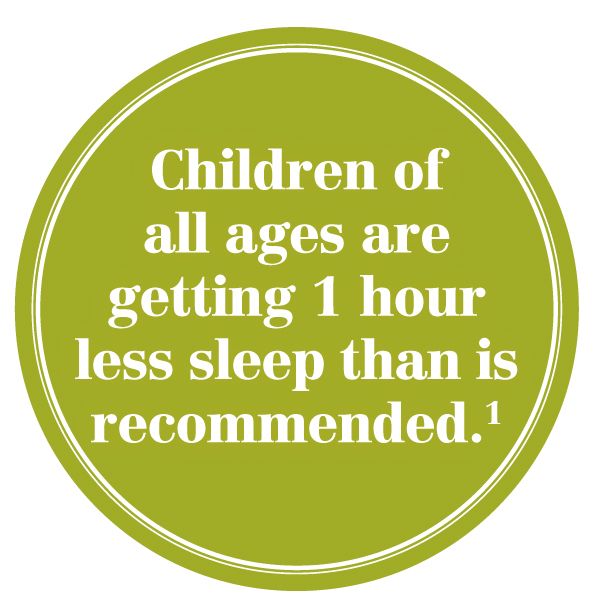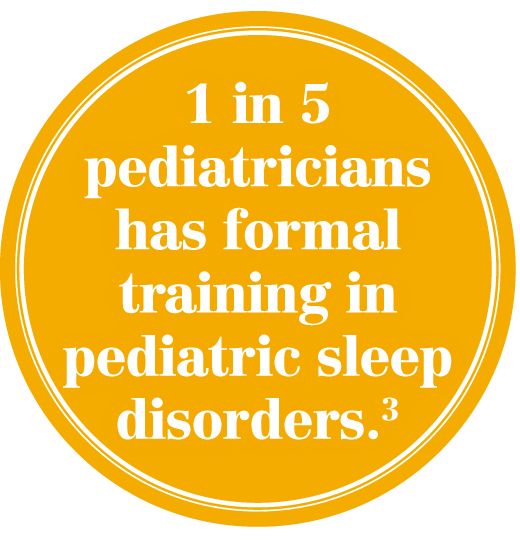Differential Dx: ADHD or sleep deficit?
Do we all need to wake up to the relationship between attention-deficit/hyperactivity disorder (ADHD) and sleep deficits in our patients?
Do we all need to wake up to the relationship between attention-deficit/hyperactivity disorder (ADHD) and sleep deficits in our patients? Could it be that a moody, inattentive, and difficult-to-control child has a sleep disorder instead of ADHD?
More sleep is something that we all need but that our patients and their parents rarely get. According to the 2014 Sleep in America poll from the National Sleep Foundation, children of all ages are, on average, getting at least an hour less sleep than is recommended, and most parents admit that their children need at least an hour more than they are currently getting.1
There is significant clinical and research data demonstrating that inadequate sleep leads to symptoms very similar to ADHD including:
• tiredness;
• difficulty focusing attention;
• learning problems; and
• impulse modulation problems.
In 1991, Dahl and colleagues were among the first to note that sleep deprivation could clinically present in a similar fashion to ADHD and that sleep-directed treatment improved the behavioral symptoms.2

Think of the busy schedules your patients or even your own kids are keeping-school activities, extracurricular activities, family activities, and homework. My own 5th-grader was like a college student recently, trying to manage end-of-year activities for school and baseball and preparing for a violin recital. Sleep disturbances may potentially be the cause of a behavioral problem that parents or schools are attributing to ADHD, or may be making existing ADHD worse.
Vatsal G. Thakkar, MD, clinical assistant professor of psychiatry at the New York University School of Medicine, shared his own sleep story in a recent New York Times editorial. He recounted his journey of performance problems, tiredness, difficulty focusing, and struggling through medical school. He was given many different diagnoses, including ADHD, but was finally found to have an atypical form of narcolepsy. Thakkar feels that pediatricians should “routinely screen for sleep disorders” and that as many as “10% of adolescents [he has] seen for behavioral issues turn out to have a primary sleep problem.”
We are, however, not well prepared. A 2011 survey of pediatricians found only 1 in 5 had received any formal training in pediatric sleep disorders.3 It is no surprise that pediatricians reporting formal training not only did better on knowledge-based assessments, but also were more confident and likely to assess for sleep problems.
Sleep and performance
Poor sleep can lead to a decreased ability to perform cognitive tasks, which may mimic ADHD. Gruber and colleagues examined the impact of 1 hour of sleep restriction over the course of 6 nights in both ADHD patients and normal controls.4 They demonstrated declines in the ability to sustain both attention and vigilance, in both normal controls and ADHD patients. In the ADHD children, the changes were significant enough to move children from a subclinical diagnostic category into a clinical one.

As our patients fill their days with more activities and less sleep, leading to later bedtimes, and as school systems seem to start earlier and earlier, what are the impacts of sleep deprivation over the long term? If we see significant declines over 6 nights in a research setting with relatively minor sleep reductions, what sort of impact might a year of “sleep debt” have? The cumulative effect of things such as kids eating dinner 30 minutes later, staying up late to do more homework, and going to bed with a smartphone could lead to significant declines in attention and vigilance over the long term.
Sleep and ADHD symptoms
Patients with sleep disorders may mimic many of the symptoms demonstrated by those with ADHD. In a study of more than 2400 children aged 6 to 15 years, children with sleep problems displayed more inattention, hyperactivity, and impulsivity as assessed by both parental and teacher reports.5 Symptoms of early sleep-disordered breathing (SDB) in the Avon Longitudinal Study of Parents and Children were associated with 40% more behavioral problems at 4 years of age and 60% more at 7 years of age compared with kids without SDB.6 In another study, looking at children over a 5-year span, children with SDB were more likely to demonstrate hyperactivity, impulsivity, aggressive behaviors, poorer social skills/communication, and decreased adaptability compared with those without SDB.7
Treating breathing problems improves behavior
A number of studies have also examined the impact of treating SDB on ADHD symptoms. Dillon and colleagues found that attention and disruptive behavior disorders decrease significantly 1 year following adenotonsillectomy.8 Wei and colleagues found that improvements in sleep and ADHD symptoms were greater at 6 months following adenotonsillectomy, but that improvements were still present 2.5 years following surgery.9 In a study that looked at children with ADHD and mild obstructive sleep apnea, patients were offered standard ADHD treatment with methylphenidate, adenotonsillectomy, or no treatment. The surgical group had greater improvements in ADHD rating scales compared with the methylphenidate-treated group.10
While not all studies have demonstrated a positive effect on behavioral symptoms following surgery, a recent meta-analysis demonstrated a positive relationship between SDB and ADHD.11 The study went on to further examine symptoms in patients treated surgically and found decreased symptoms 2 to 13 months following surgery.
What should I do in my practice?
It seems reasonable that there is at least a relationship between SDB and neurobehavioral problems. It also seems reasonable to consider surgical treatment in patients where appropriate.
At a minimum, “screening [for sleep disorders] should be done for every child on stimulant treatment,” according to Thakkar. This does not mean that every child needs a formal sleep study, but some sort of formal assessment is required. While polysomnography is the gold standard for some sleep disorders, a pediatric sleep specialist or lab may not be available to you. A screening questionnaire will help you make a good assessment of whether a sleep problem may be contributing to your patient’s behavioral problem. If your patient has significant symptoms related to sleep, you may want to get a formal assessment, consult a sleep specialist, or consider treating the sleep problem before starting a stimulant.
One helpful option is a focused and standardized history provided by parents or taken by you or a member of your staff. Mindell12 and Owens13 suggest asking all parents about BEARS. The acronym guides you to ask about:
- Bedtime problems;
- Excessive daytime sleepiness;
- Awakening at nighttime;
- Regular bedtime and awakening time; and
- Snoring or other difficulty breathing at night.
One more formal tool is the free, parent-administered Pediatric Sleep Questionnaire, or PSQ.14 The tool screens for a number of specific pediatric sleep disorders, such as obstructive sleep apnea and periodic leg movements, and includes scales targeting for snoring, sleepiness, and daytime disruptive behavior. The daytime disruptive behavior scale is based on the Diagnostic and Statistical Manual of Mental Disorders, Fourth Edition, symptoms for inattentive, hyperactive, and impulsive behavior. A more comprehensive sleep questionnaire and sleep diary is also freely available from the University of Chicago Medicine Comer Children’s Hospital Section of Pediatric Sleep Medicine.15

Final thoughts
As with the calories in/calories out (eat less and exercise more) argument related to the treatment of obesity, it is easy to tell parents to improve their children’s sleep hygiene and set a regular bedtime. In the face of overwhelming activities, schoolwork, video games, caffeinated drinks, social media, and other choices of a modern lifestyle, however, a quick solution seems unlikely. Rather, improving sleep may take a significant therapeutic effort on our part to help parents understand all the different things that can impact sleep and the subsequent consequences of poor sleep. As a parent myself, I am wondering whether my kids should just do less. School start times and homework will continue to be debated, and I believe sleep will continue to be an issue in those discussions.
In terms of our practice, pediatricians need to become educated on the consequences of poor sleep; the ways we can assess sleep in our patients; and how to address poor sleep habits when we see them. At a minimum, I will think about assessing sleep more thoroughly before I consider a stimulant medication for one of my patients in the future.
REFERENCES
1. National Sleep Foundation. 2014 Sleep in America Poll: Sleep in the Modern Family. Available at: http://sleepfoundation.org/sleep-polls-data/sleep-in-america-poll/2014-sleep-in-the-modern-family/. Published March 2014. Accessed June 25, 2014.
2. Dahl RE, Pelham WE, Wierson M. The role of sleep disturbances in attention deficit disorder symptoms: a case study. J Pediatr Psychol. 1991;16(2):229-239.
3. Faruqui F, Khubchandani J, Price JH, Bolyard D, Reddy R. Sleep disorders in children: a national assessment of primary care pediatrician practices and perceptions. Pediatrics. 2011;128(3):539-546.
4. Gruber R, Wiebe S, Montecalvo L, Brunetti B, Amsel R, Carrier J. Impact of sleep restriction on neurobehavioral functioning of children with attention deficit hyperactivity disorder. Sleep. 2011;34(3):315-323.
5. Shur-Fen Gau S. Prevalence of sleep problems and their association with inattention/hyperactivity among children aged 6-15 in Taiwan. J Sleep Res. 2006;15(4):403-414. Erratum in; J Sleep Res. 2010;19(2):379.
6. Bonuck K, Freeman K, Chervin RD, Xu L. Sleep-disordered breathing in a population-based cohort: behavioral outcomes at 4 and 7 years. Pediatrics. 2012;129(4):e857-e865.
7. Perfect MM, Archbold K, Goodwin JL, Levine-Donnerstein D, Quan SF. Risk of behavioral and adaptive functioning difficulties in youth with previous and current sleep disordered breathing. Sleep. 2013;36(4):517-525B.
8. Dillon JE, Blunden S, Ruzicka DL, et al. DSM-IV diagnoses and obstructive sleep apnea in children before and 1 year after adenotonsillectomy. J Am Acad Child Adolesc Psychiatry. 2007;46(11):1425-1436.
9. Wei JL, Bond J, Mayo MS, Smith HJ, Reese M, Weatherly RA. Improved behavior and sleep after adenotonsillectomy in children with sleep-disordered breathing: long-term follow-up. Arch Otolaryngol Head Neck Surg. 2009;135(7):642-646.
10. Huang YS, Guilleminault C, Li HY, Yang CM, Wu YY, Chen NH. Attention-deficit/hyperactivity disorder with obstructive sleep apnea: a treatment outcome study. Sleep Med. 2007;8(1):18-30.
11. Sedky K, Bennett DS, Carvalho KS. Attention deficit hyperactivity disorder and sleep disordered breathing in pediatric populations: a meta-analysis. Sleep Med Rev. 2014;18(4):349-356.
12. Mindell JA, Owens JA. A Clinical Guide to Pediatric Sleep: Diagnosis and Management of Sleep Problems. Philadelphia, PA: Lippincott Williams & Wilkins; 2003.
13. Owens JA, Dalzell V. Use of the 'BEARS' sleep screening tool in a pediatric residents' continuity clinic: a pilot study. Sleep Med. 2005;6(1):63-69.
14. Chervin RD, Weatherly RA, Garetz SL, et al. Pediatric sleep questionnaire: prediction of sleep apnea and outcomes. Arch Otolaryngol Head Neck Surg. 2007;133(3):216-222.
15. Gozal D, Bandla H; University of Chicago Comer Children’s Hospital Section of Pediatric Sleep Medicine. Pediatric Sleep Medicine Questionnaire. Available at: http://www.uchicagokidshospital.org/pdf/uch1001270.pdf. Accessed June 25, 2014.
Dr Bass is chief medical information officer and associate professor of medicine and pediatrics, Louisiana State University Health Science Center–Shreveport, Louisiana. The author has nothing to disclose in regard to affiliations with or financial interests in any organizations that may have an interest in any part of this article.
New research finds significant challenges for children with disabilities in foster care
September 27th 2024A study presented at the American Academy of Pediatrics 2024 National Conference finds children with disabilities in foster care face lower permanency rates and higher mortality risks, calling for specialized support and interventions.